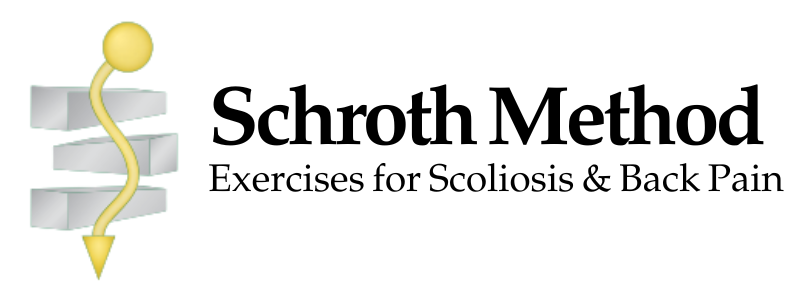Don't Let Your Child Undergo Surgery
Schroth Exercises Can Reduce Curves Safely
Spinal fusion surgery to try to straighten a scoliotic spine is almost never necessary. Even if your doctor recommends that, try Schroth exercises first.
- Correct spinal rotation and increase lung capacity with a rotational breathing technique
- Help restore normal spinal position with a special breathing technique
- Improve your posture during routine daily living, not just during therapy

12-year-old girl with Scheuermann's kyphosis (left).

After five weeks of Schroth treatment (right).
The Definitive Handbook
on Schroth Exercises

Written by Christa Lehnert-Schroth, P.T. this book includes:
- Over 100 scoliosis exercises – with photos
- Treatments for 3, as well as 4-curve configurations, which the author discovered, and which are actually more common than many doctors realize
- Exercises for Scheuermann’s kyphosis, flatback, hollow-back syndrome (hyperlordosis), lumbar kyphosis, spondylolisthesis, and related pathologies
"I have remained an adherent of Scroth therapy right up to the present day. I haven't been sick in bed for one day in 50 years, and I'm also not under doctor's care or on any drugs. Despite my 88 years and severe scoliosis, I'm still fit."
Georg S.
Why Avoid Surgery?
Surgery is not a cure, but rather, in the words of Dr. Hans-Rudolf Weiss (grandson of Katharina Schroth), it substitutes one pathology — a stiff spine — for another. The unsolved underlying issue, paraspinal muscular imbalances, means that the spine may continue to twist above and below the fusion, causing pain or other problems as the patient ages. If the patient has already had surgery, Schroth therapy can help restore normal posture and reduce pain.
Since spinal fusion is extremely invasive, there is risk of adverse consequences such as pain, infection, broken implants, failed fusion, and necessity of revision surgery. The more surgeries, the higher the probability of complications, including death. See this study: Mortality and Morbidity in Early-Onset Scoliosis Surgery.
3 Success Stories
In 1991 a clinical study compared patients with Adolescent Idiopathic Scoliosis (AIS) at two clinics: an Irish clinic that does NOT practice the Schroth Method, and Dr. Rigo’s Schroth Method clinic in Barcelona.
- 28% of the patients at the Irish clinic went on to have spinal fusion surgery
- Only 6% of patients at Dr. Rigo’s Schroth Method clinic had to undergo surgery
A control group of untreated patients was compared to a similar group that received scoliosis in-patient rehabilitation (SIR) at the Katharina Schroth Klinik. Some of the SIR patients had more severe curvatures. However, the untreated control group’s curvature progressed 2 – 3 times more than those treated with SIR according to the Schroth Method.
This study begun in 1989 included 181 scoliosis patients with:
- Average age: 12.7 years
- Average Cobb angle curvature: 27 degrees
- Average risser sign: 1.4
After an average follow up of 33 months, there was no progression of curvature
Find Out How the Schroth Method for Scoliosis Can Help You
Educate yourself on the exercises that therapists use to treat scoliosis
Additional Resources
Why Schroth Method?
- Reduces Pain
- Stops Curve Progression
- Increases Lung Capacity
Without the need for surgery.
Try Schroth Exercises first!
The information and links to therapists provided on this site are intended for informational purposes only. While we strive to ensure the accuracy and currency of our listings, we cannot guarantee that all information is up-to-date or that all therapists are currently accepting new clients. We strongly recommend that you perform your own due diligence by conducting a thorough Google search and verifying the credentials, availability, and suitability of any therapist you wish to contact. This site does not endorse or recommend any specific therapist and assumes no responsibility for the services provided by any listed professional. Your use of this site and reliance on any information provided is solely at your own risk.


